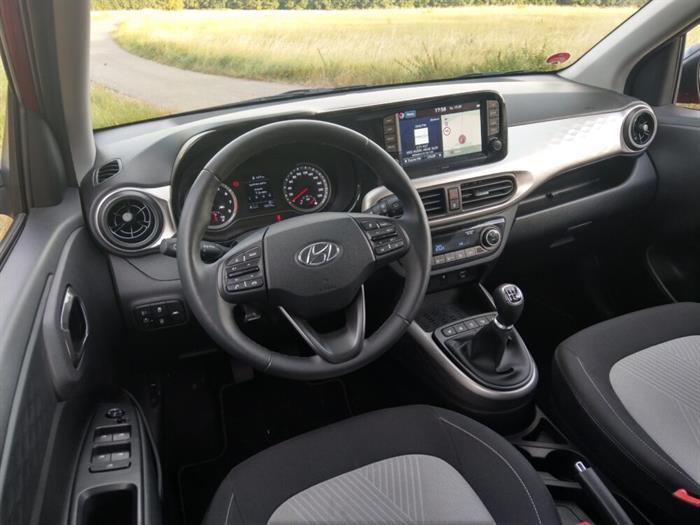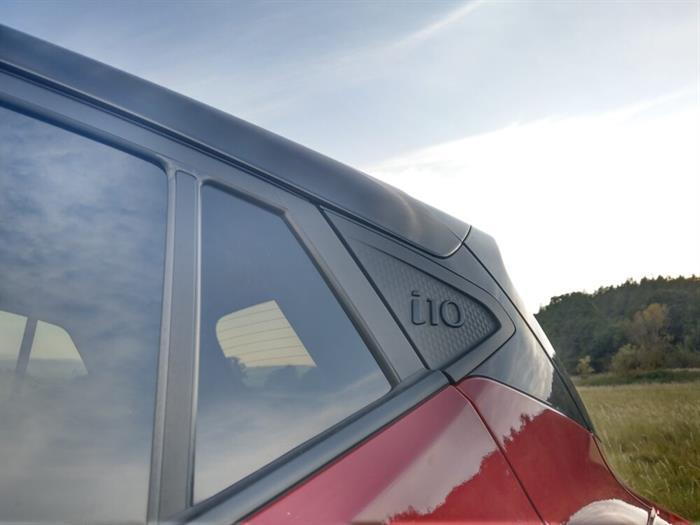The smallest of the Hyundai car portfolio has reached its third generation. And I have to admit that with the new generation we got a much more handsome car, which now offers significantly more robustness and dynamic shapes.
We subjected the car to the editorial test, which was equipped with a basic gasoline three-cylinder engine, a five-speed manual and the Style equipment supplemented with the additional Premium package.

Exterior
As I have already announced, the new generation i10 has undergone minor proportional corrections, the car is now lower and at the same time wider, and now it has a longer wheelbase of approx. 4 cm. The Hyundai i10 has therefore become considerably more powerful for us visually, and thanks to imaginatively designed details, it now looks much better.
The front part will offer elegantly cut headlights, a richly shaped bumper and a large front mask with integrated circular daytime running lights. The discreet moldings that decorate the front hood are also worth noting.
Within the side profile, the dynamic shaping of the entire bodywork is most noticeable, and the car's two-tone paint job is very effective. I must also praise the design of the 16" wheels of the tested car.
The advertised robustness is widely applied when looking at the rear of the car. The fenders above the rear wheels are gently pushed out of the body, and the car thus has a relatively sure and stable stance. The detail of the shaping of the rear fifth door is also very nice, which connects the two tail lamps and brings an elegant horizontal element to this part.

Interior
The interior of the new "ten" itself will offer a fairly well-known layout within the car company, which traditionally has very good internal ergonomics. I also have to praise the nice decor, which is equipped with the dashboard in front of the passenger, or in the interior of the doors.
Unfortunately, the weak points of the interior include the presence of harder plastics and the not entirely pleasant "scratch" that new Hyundai car interiors sometimes have.
The dashboard now combines the instrument cluster in front of the driver with the on-board infotainment display into one compact unit. In the instrument cluster in front of the driver, there are two classic analog indicators, a speedometer and a tachometer, as well as a digital display of the on-board computer. So here the new generation i10 sticks to the old proven classic.
It is the same with the on-board infotainment display, which still has the same environment, only with slightly better graphics. It goes without saying that you can connect via Apple Car Play or Android Auto.
The interior of the new generation i10 is quite spacious, even in the rear seats. Here, the intergenerational increase in the car's wheelbase had a very positive effect.
The luggage compartment has a basic volume of 250 liters and has relatively decent floor plan dimensions.
The interior of the new i10 will please you with its good interior space and rich equipment. The piece we tested was equipped with, for example, heated front seats, a heated and height-adjustable multifunction steering wheel, digital air conditioning or keyless entry and start as part of the STYLE equipment and the Premium package.

Offered motorizations and driving impressions
The new generation Hyundai i10 comes with three petrol engines. The basis is a liter three-cylinder engine with 67 horsepower, the next option is a four-cylinder twelve-cylinder engine with 84 horsepower. The top version of the i10 N Line will also offer a turbocharged liter engine that has a power of 100 horsepower.
Although our editorial car was richly equipped (STYLE equipment + Premium package), it was fitted with the weakest advertised engine, i.e. a 67-horsepower three-cylinder.
The liter engine tested was characterized by relatively quiet and refined operation, but on the other hand, it won't bring much of a smile to your face. The engine revs up to around 3000 rpm. Until then, its reactions to the gas pedal are very lukewarm. A more nimble ride, which, however, is not alien to the car, requires more frequent shifting and a higher range of revolutions. The consumption of this engine depends a lot on your driving style, with the car I used between 5 and 6 liters per 100 km.
The new lower and wider body structure together with the longer wheelbase had a positive effect on the behavior of the chassis of the third generation i10. The chassis is quite confident in corners and can be comfortable enough in urban traffic.

In conclusion
You can buy the new generation Hyundai i10 from a decent 229,900 CZK including VAT, within the promotional price. This is a basic variant with Start equipment, a liter engine and a five-speed manual transmission.
Hyundai i10 is also available in COMFORT, SMART, N Line, STYLE and N Line STYLE trim levels. The piece tested by us, which had the STYLE equipment, can be purchased with a liter engine from CZK 319,990 including VAT.
You will then pay an additional 50,000 CZK for the Premium package. This package then enriches the car with a roof in a different color design, 16" wheels, integrated navigation with an 8" touch screen, keyless access and starting the car with a button, or a traffic sign recognition function.
Thanks to its dimensional corrections, the Hyundai i10 of the third generation has become a very elegant and dynamically cut car. Tested, the piece did not impress with its weaker power unit, but pleasantly surprised with its interior spaciousness and rich equipment.
Source: Author's text
Image source: Author's own photos























